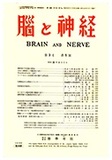Japanese
English
- 有料閲覧
- Abstract 文献概要
I.緒論
Sherrington (1898)(1)は實驗動物の大脳半球を剔除して四膝及び躯幹筋に特有の伸筋硬直の起ることを認めて,この現象を去脳硬直と名付けた。其後各方面の注目を惹いて研究者が相次いだが,去脳ということは上位脳とそれ以下との連絡を絶つことを前提とするために,この去脳硬直現象と上位神經中樞との關係についての研究は全く不可能であつた。
著者は名和及び佐藤と共に(3)中脳正中線上に幅約3mm以下の短横斷を加うることによつて去脳硬直と全く同じ硬直状態を骨酪筋に發現せしめることに成功し,これを短横斷硬直と名付けた。この方法によると上位脳と中脳以下とは正中線上に於て極めて限局された損傷を受けるのみで連絡し,他部は全く健存するので上位中樞の硬直現象に對する關係を新しい觀點から追究することが出來る。然もこの短横斷によつて實驗動物の一般状態は殆ど犯されないので慢性實驗も可能である。
By the partial transection at the central grey matter of midbrain, the decerebrate rigi-dity in the sense of Sherrington resulted.
From the observations of this, animal the, author concluded as follows.
(1) The dog partially trasected at midbrain could stand and walk almost as normal. This dog's pyramidal motor system was quite intact and the dog could behave objectively.
(2) This dog's posture and symptoms (rigi-dity, intensified tendon reflex etc.) were the same as the so-called clinical pyramidal sym-ptoms, but these were believed in this case due to the extrapyramidal injury.
Copyright © 1951, Igaku-Shoin Ltd. All rights reserved.


